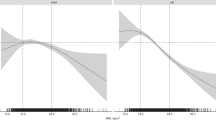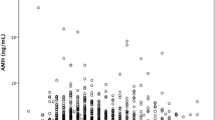Abstract
Objective
Previous studies regarding the effect of obesity on serum anti-müllerian hormone (AMH) levels have been conflicting. Our aim was to determine the effect of obesity on serum AMH levels among women from different racial backgrounds.
Methods
The medical records of 350 women (159 Caucasian, 99 African-American, 58 Hispanic, 34 Asian with ages 16–46) evaluated for infertility at an academic-affiliated center and who had AMH levels measured as part of their evaluation were reviewed. Age, AMH, body mass index (BMI), self-reported race, etiology of infertility, smoking history, maximum serum early follicular follicle-stimulating hormone (FSH) levels, antral follicle count (AFC), and history of ovarian surgery, chemotherapy, or radiotherapy were recorded.
Results
Age correlated negatively with AMH and antral follicle count across all races (p < 0.05). After adjusting for age, polycystic ovary syndrome diagnosis, and smoking, elevated BMI had a negative correlation with AMH in Caucasian women (β = 0.17, p = 0.01) but not in African-American, Hispanic, or Asian women.
Conclusion
Elevated BMI correlates negatively with AMH in Caucasian women but not in African-American, Hispanic, or Asian women. Additional studies are needed to elucidate further the effect of race on the interaction between obesity and ovarian reserve.

Similar content being viewed by others
References
Flegal KM, Carroll MD, Kit BK, Ogden CL. Prevalence of obesity and trends in the distribution of body mass index among US adults, 1999–2010. JAMA. 2012;307(5):491–7. doi:10.1001/jama.2012.39.
Pasquali R, Patton L, Gambineri A. Obesity and infertility. Curr Opin Endocrinol Diabetes Obes. 2007;14(6):482–7. doi:10.1097/MED.0b013e3282f1d6cb.
Epplein M, Reed SD, Voigt LF, Newton KM, Holt VL, Weiss NS. Risk of complex and atypical endometrial hyperplasia in relation to anthropometric measures and reproductive history. Am J Epidemiol. 2008;168(6):563–70. doi:10.1093/aje/kwn168. discussion 71–6.
Rich-Edwards JW, Spiegelman D, Garland M, Hertzmark E, Hunter DJ, Colditz GA, et al. Physical activity, body mass index, and ovulatory disorder infertility. Epidemiology. 2002;13(2):184–90.
Boots C, Stephenson MD. Does obesity increase the risk of miscarriage in spontaneous conception: a systematic review. Semin Reprod Med. 2011;29(6):507–13. doi:10.1055/s-0031-1293204.
Marshall NE, Spong CY. Obesity, pregnancy complications, and birth outcomes. Semin Reprod Med. 2012;30(6):465–71. doi:10.1055/s-0032-1328874.
Gesink Law DC, Maclehose RF, Longnecker MP. Obesity and time to pregnancy. Hum Reprod. 2007;22(2):414–20. doi:10.1093/humrep/del400.
van der Steeg JW, Steures P, Eijkemans MJ, Habbema JD, Hompes PG, Burggraaff JM, et al. Obesity affects spontaneous pregnancy chances in subfertile, ovulatory women. Hum Reprod. 2008;23(2):324–8. doi:10.1093/humrep/dem371.
Maheshwari A, Stofberg L, Bhattacharya S. Effect of overweight and obesity on assisted reproductive technology—a systematic review. Hum Reprod Update. 2007;13(5):433–44. doi:10.1093/humupd/dmm017.
Pinborg A, Gaarslev C, Hougaard CO, Nyboe Andersen A, Andersen PK, Boivin J, et al. Influence of female bodyweight on IVF outcome: a longitudinal multicentre cohort study of 487 infertile couples. Reprod Biomed Online. 2011;23(4):490–9. doi:10.1016/j.rbmo.2011.06.010.
Luke B, Brown MB, Missmer SA, Bukulmez O, Leach R, Stern JE, et al. The effect of increasing obesity on the response to and outcome of assisted reproductive technology: a national study. Fertil Steril. 2011;96(4):820–5. doi:10.1016/j.fertnstert.2011.07.1100.
Moragianni VA, Jones SM, Ryley DA. The effect of body mass index on the outcomes of first assisted reproductive technology cycles. Fertil Steril. 2012;98(1):102–8. doi:10.1016/j.fertnstert.2012.04.004.
Rittenberg V, Seshadri S, Sunkara SK, Sobaleva S, Oteng-Ntim E, El-Toukhy T. Effect of body mass index on IVF treatment outcome: an updated systematic review and meta-analysis. Reprod Biomed Online. 2011;23(4):421–39. doi:10.1016/j.rbmo.2011.06.018.
Robker RL, Akison LK, Bennett BD, Thrupp PN, Chura LR, Russell DL, et al. Obese women exhibit differences in ovarian metabolites, hormones, and gene expression compared with moderate-weight women. J Clin Endocrinol Metab. 2009;94(5):1533–40. doi:10.1210/jc.2008-2648.
Levi AJ, Raynault MF, Bergh PA, Drews MR, Miller BT, Scott Jr RT. Reproductive outcome in patients with diminished ovarian reserve. Fertil Steril. 2001;76(4):666–9.
Riggs RM, Duran EH, Baker MW, Kimble TD, Hobeika E, Yin L, et al. Assessment of ovarian reserve with anti-Mullerian hormone: a comparison of the predictive value of anti-Mullerian hormone, follicle-stimulating hormone, inhibin B, and age. Am J Obstet Gynecol. 2008;199(2):202 e1–8. doi:10.1016/j.ajog.2008.05.004.
van Rooij IA, Broekmans FJ, Scheffer GJ, Looman CW, Habbema JD, de Jong FH, et al. Serum antimullerian hormone levels best reflect the reproductive decline with age in normal women with proven fertility: a longitudinal study. Fertil Steril. 2005;83(4):979–87. doi:10.1016/j.fertnstert.2004.11.029.
Seifer DB, Maclaughlin DT. Mullerian inhibiting substance is an ovarian growth factor of emerging clinical significance. Fertil Steril. 2007;88(3):539–46. doi:10.1016/j.fertnstert.2007.02.014.
Shaw CM, Stanczyk FZ, Egleston BL, Kahle LL, Spittle CS, Godwin AK, et al. Serum antimullerian hormone in healthy premenopausal women. Fertil Steril. 2011;95(8):2718–21. doi:10.1016/j.fertnstert.2011.05.051.
Sahmay S, Usta T, Erel CT, Imamoglu M, Kucuk M, Atakul N, et al. Is there any correlation between amh and obesity in premenopausal women? Arch Gynecol Obstet. 2012;286(3):661–5. doi:10.1007/s00404-012-2363-x.
Halawaty S, ElKattan E, Azab H, ElGhamry N, Al-Inany H. Effect of obesity on parameters of ovarian reserve in premenopausal women. JOGC J Obstetrique et Gyn Can JOGC. 2010;32(7):687–90.
Freeman EW, Gracia CR, Sammel MD, Lin H, Lim LC, Strauss 3rd JF. Association of anti-mullerian hormone levels with obesity in late reproductive-age women. Fertil Steril. 2007;87(1):101–6. doi:10.1016/j.fertnstert.2006.05.074.
Buyuk E, Seifer DB, Illions E, Grazi RV, Lieman H. Elevated body mass index is associated with lower serum anti-mullerian hormone levels in infertile women with diminished ovarian reserve but not with normal ovarian reserve. Fertil Steril. 2011;95(7):2364–8. doi:10.1016/j.fertnstert.2011.03.081.
Butts SF, Seifer DB. Racial and ethnic differences in reproductive potential across the life cycle. Fertil Steril. 2010;93(3):681–90. doi:10.1016/j.fertnstert.2009.10.047.
Seifer DB, Golub ET, Lambert-Messerlian G, Benning L, Anastos K, Watts DH, et al. Variations in serum mullerian inhibiting substance between White, Black, and Hispanic women. Fertil Steril. 2009;92(5):1674–8. doi:10.1016/j.fertnstert.2008.08.110.
Bleil ME, Gregorich SE, Adler NE, Sternfeld B, Rosen MP, Cedars MI. Race/ethnic disparities in reproductive age: an examination of ovarian reserve estimates across four race/ethnic groups of healthy, regularly cycling women. Fertil Steril. 2014;101(1):199–207. doi:10.1016/j.fertnstert.2013.09.015.
Rotterdam EA-SPCWG. Revised 2003 consensus on diagnostic criteria and long-term health risks related to polycystic ovary syndrome. Fertil Steril. 2004;81(1):19–25.
Robker RL, Wu LL, Yang X. Inflammatory pathways linking obesity and ovarian dysfunction. J Reprod Immunol. 2011;88(2):142–8. doi:10.1016/j.jri.2011.01.008.
Merhi Z, Buyuk E, Berger DS, Zapantis A, Israel DD, Chua Jr S, et al. Leptin suppresses anti-Mullerian hormone gene expression through the JAK2/STAT3 pathway in luteinized granulosa cells of women undergoing IVF. Hum Reprod. 2013;28(6):1661–9. doi:10.1093/humrep/det072.
Seifer DB, Baker VL, Leader B. Age-specific serum anti-Mullerian hormone values for 17,120 women presenting to fertility centers within the United States. Fertil Steril. 2011;95(2):747–50. doi:10.1016/j.fertnstert.2010.10.011.
Nelson SM, Messow MC, Wallace AM, Fleming R, McConnachie A. Nomogram for the decline in serum antimullerian hormone: a population study of 9,601 infertility patients. Fertil Steril. 2011;95(2):736–41 e1-3. doi:10.1016/j.fertnstert.2010.08.022.
Scheffer GJ, Broekmans FJ, Dorland M, Habbema JD, Looman CW, te Velde ER. Antral follicle counts by transvaginal ultrasonography are related to age in women with proven natural fertility. Fertil Steril. 1999;72(5):845–51.
Rosen MP, Johnstone E, McCulloch CE, Schuh-Huerta SM, Sternfeld B, Reijo-Pera RA, et al. A characterization of the relationship of ovarian reserve markers with age. Fertil Steril. 2012;97(1):238–43. doi:10.1016/j.fertnstert.2011.10.031.
Khan UI, Wang D, Sowers MR, Mancuso P, Everson-Rose SA, Scherer PE, et al. Race-ethnic differences in adipokine levels: the Study of Women’s Health Across the Nation (SWAN). Metab Clin Exp. 2012;61(9):1261–9. doi:10.1016/j.metabol.2012.02.005.
Azrad M, Gower BA, Hunter GR, Nagy TR. Racial differences in adiponectin and leptin in healthy premenopausal women. Endocrine. 2013;43(3):586–92. doi:10.1007/s12020-012-9797-6.
Woo HY, Kim KH, Rhee EJ, Park H, Lee MK. Differences of the association of anti-Mullerian hormone with clinical or biochemical characteristics between women with and without polycystic ovary syndrome. Endocr J. 2012;59(9):781–90.
Cassar S, Teede HJ, Moran LJ, Joham AE, Harrison CL, Strauss BJ, et al. Polycystic ovary syndrome and anti-Mullerian hormone: role of insulin resistance, androgens, obesity and gonadotrophins. Clin Endocrinol. 2014;81(6):899–906. doi:10.1111/cen.12557.
Piouka A, Farmakiotis D, Katsikis I, Macut D, Gerou S, Panidis D. Anti-Mullerian hormone levels reflect severity of PCOS but are negatively influenced by obesity: relationship with increased luteinizing hormone levels. Am J Physiol Endocrinol Metab. 2009;296(2):E238–43. doi:10.1152/ajpendo.90684.2008.
Author information
Authors and Affiliations
Corresponding author
Additional information
Capsule
Elevated BMI correlates negatively with AMH in Caucasian women but not in African-American, Hispanic, or Asian women.
Rights and permissions
About this article
Cite this article
Moy, V., Jindal, S., Lieman, H. et al. Obesity adversely affects serum anti-müllerian hormone (AMH) levels in Caucasian women. J Assist Reprod Genet 32, 1305–1311 (2015). https://doi.org/10.1007/s10815-015-0538-7
Received:
Accepted:
Published:
Issue Date:
DOI: https://doi.org/10.1007/s10815-015-0538-7




